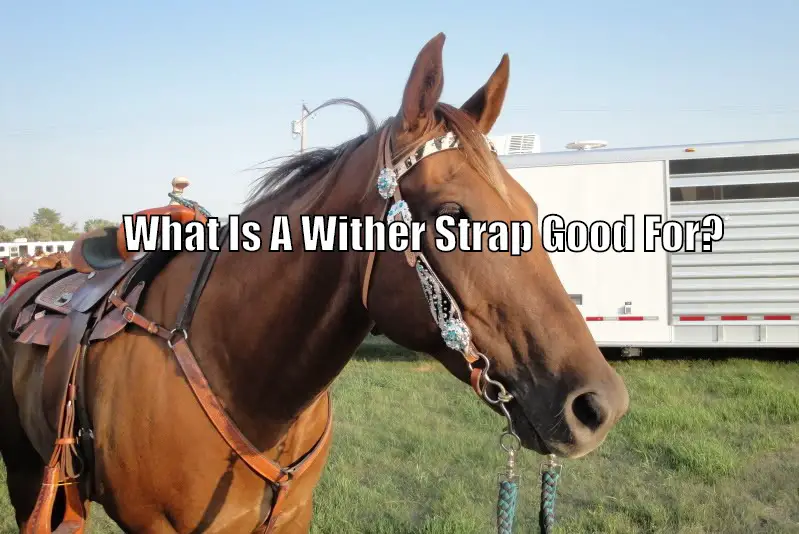Attaching of the wither strap and mooring
Attaching of the wither strap and the mooring are among the most common and important moments of horse’s care. However, if you take into account some of the rules, it goes quite easily and quickly.
What is a wither strap good for? An ordinary wither strap supplies a noseband and a neck strep bridle without a bit. They attach a lunge (about 150 cm) to it to guide the horse and tie it if necessary.
The headband is made of a double-width material to form the split part of the face and the chin strap at the end. A buckle piece is sewn crosswise to the center of the headband for attachment to the blinders-holder. The noseband can be made in a simpler design, with only one buckle sewn into the weaker end with 2 holes.
When we start to deal with a young horse, we need a forced break. This is an iron-fastened brace, which serves to keep the young horse under control at the nose when gripping and at the beginning of the training.
This prevents your lips from being “pulled” – which is very good for the future if it remains sensitive.
Wither strap in the barn and in the paddock
There are some horse keepers who think that a horse should wear a wither strap. But is it really necessary? In fact, in two cases, there is really need for a wither strap: if we drive or tie the horse. In the barn, in the paddock or on the pasture, no need for a wither strap!
Wither strap in the paddock?
For several reasons, it is not advisable to put a wither strap on the horses in the paddock. On the one hand, it can easily get caught up in it, such as a protruding fence column, a tree branch, a drinking device, or a horse’s own foot when scratching. The panic situation that such a hitch causes, and of course, the associated risk of injury should not be underestimated at all!
Another reason for horse-riding, also due to laziness, why they leave the wither strap on the horses in the paddock is to make it easier to catch the horse. Which is undoubtedly an easiness for the farmer, it also makes it easier for the horse thieves to do, and even “tempts” them to simply take the unguarded horse.
The problem is, of course, how to grab and drive the horse from the pasture, if there is no wither strap on it, and it is hardly willing to come home to the barn. Everyone has to figure out a suitable method for this, but maybe this should be the slightest trouble.
Wither strap in the stall
Do you really need it? It is not impossible to catch the horse on up to twelve square meters. If it doesn’t go, then it is not the lack of a whiter strap for the reason and not the wither strap is the solution. The horse probably has a reason not to let itself get caught, so this reason should be removed as soon as possible and not cling to the wither strap in every sense of the word.
A horse that does not have confidence in an owner without a wither strap will not be a reliable companion during riding. Nowadays, many wither straps are available in the range of equestrian shops, so everyone can find the one that suits their needs and those of their horses.
But let’s look at the advantages and disadvantages of the most commonly used versions!
The classic leather wither strap
The leather wither strap is a beautiful, elegant and durable tool that, with proper care, “survives” the horse. The only problem is that it is usually difficult to set up well, that is, usually only a certain horse fits properly. Most of them can be opened at the throat or at the neck strap, but the noseband is usually too large and cannot be controlled.
The leather wither strap is best suited for tying the horse safely, trustworthy help in transport, for example. However, if the horse is frightened of something and wants to get rid of it, the over-loose strap will cause the entire wither strap to turn on the horse’s head and the horse’s eyes can easily be damaged.
Perlon wither strap
Nowadays, these are the most commonly used wither straps as they are relatively inexpensive and available in all variants from subdued, from elegant dark blue to lush yellow. Of course, each of them has its own advantage, as the brilliantly colored and patterned wither strap can know immediately which horse, even if its master has forgotten somewhere. In addition, we can find it more easily in the grass or even among the coal bales if they are lost.
Unlike leather, they can be washed in a washing machine at 40 degrees, so they always look like they’re brand new. However, their weaknesses are the buckles and locks on them. These are theoretically made of stainless material, but this is not always the case, and the rusty buckle, the carabiner can easily terminate the service – of course, always in a critical moment. It can be expected to be able to control several points.
In summary
No matter how attractive a halter is, don’t choose fashion based on practicality and safety at the time of purchase! And in the paddock or on the pasture, don’t just leave a wither strap on the horse’s head so the neighbor can see how good we chose in the horse shop.
The wither strap is always made of thick, sufficiently soft material and can be adjusted in several places, and is used only when absolutely necessary, otherwise, let the horses move freely in the paddock without any tools.

